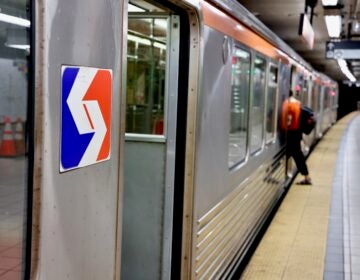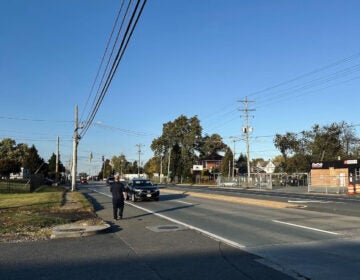PennDOT, Wolf announce a series of small tweaks to I-76 aimed at easing traffic

As Gov. Tom Wolf announced a multiyear, $8.6 million initiative to ease traffic on the notoriously gridlocked Schuylkill Expressway, he intimated a familiarity with the frustrations faced by area commuters.
“It doesn’t matter what time of the day you travel on the Schuylkill,” said Wolf, “it just seems to be always crowded, and that’s a problem.”
Standing in front of a wall of flat-screen displays at PennDOT’s regional traffic-management center that monitor local road conditions, Wolf downplayed hopes of magically freeing up the freeway.
“This will not, in and of itself, solve all the problems,” he said as a display behind him showed a long line of cars crawling along on I-76 near the Conshohocken curve. “But it’s a real start and an important start.”
The initial phase of the initiative will see new digital signs installed on I-76 that will warn motorists of upcoming jams around the bend. PennDOT will also implement variable speed limits along the expressway, meaning the road’s top legal speeds will be adjusted up or down to match real-time traffic and weather conditions. Work on this first phase should wrap up in summer 2019.
Perhaps the largest of the many changes announced is also likely to be the last implemented: converting the highway’s shoulders into travel lanes along some stretches of I-76. PennDOT Secretary Leslie Richards said her agency, along with state and local police, traveled to Virginia to study highways there that made the switch, and determined that the added capacity outweighed the risk of massive backlogs caused by kaput cars and no breakdown lanes.
Richards also tempered expectations that the changes would suddenly remove the Schuylkill Expressway’s oxymoronic undertones.
“It’s not going to turn it into the Pocono Raceway,” she said. “I-76 is still going to have issues. We’re trying to manage over 135,000 cars a day up in the Montgomery County area [and] over 200,000 in the Philadelphia area.”
Built over the 1950s, the expressway was designed to handle just 35,000 cars per day, but traffic volumes quickly surpassed that, thanks in large part to the highway’s recursive relationship to suburban sprawl: As more segments of I-76 opened up, the easier the commute into the city became, enticing more (mostly white) Philadelphians to move out.
Highways tend to run into the problem of induced demand, a “build it and they will come” economic theory explaining a peculiar kind market failure. Here, increasing the supply of fast-moving lanes leads to corresponding increases in the number of automobiles on those lanes, which eventually slows everything down to a crawl.
So even if PennDOT could widen the Schuylkill Expressway, it probably would only encourage more suburbanites to live along the route and use it, filling up that added capacity and ultimately solving little.
The tweaks unveiled at Thursday’s press conference seemed designed more at smoothing traffic flows rather than reducing the volume — collectively, they will form a spout, not a spigot. Some of the other changes are aimed at encouraging commuters toward lighter-traveled alternate routes and public transit, such as new signs to let gridlocked drivers know when and where they could catch the nearest SEPTA train. Wolf also touted ongoing efforts to improve Regional Rail service.
Just how many will be able to swap their car keys for SEPTA Key cards thanks to this effort remains to be seen. The Manayunk/Norristown line, which runs largely parallel to I-76, is SEPTA’s sixth most-ridden Regional Rail line, with 11,187 daily riders. During the weekday rush hours, trains are scheduled to come every 23 to 24 minutes, and only hourly during off-peak times.
Richards also said that new traffic signals on the Schuylkill Expressway’s tributary routes will try to control the flow onto entrance ramps, in the hopes of ameliorating merger headaches.
Eighty percent of the project’s price tag will be covered by federal grants, with the state paying the rest. Work installing the new signs and signals is not expected to create significant traffic delays.
WHYY is your source for fact-based, in-depth journalism and information. As a nonprofit organization, we rely on financial support from readers like you. Please give today.






